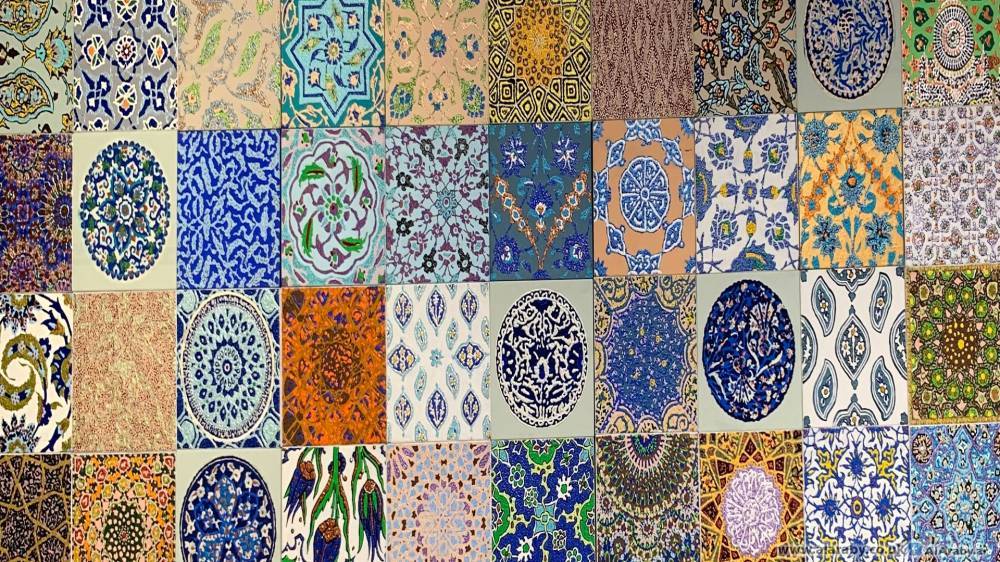
Sharjah: Osman Hassan
Turkish decoration in the Islamic style was popularized as a distinct school, whose roots go back to the Egyptian and Levantine schools and ancient Arabic manuscripts. One of the most talented decorators in this field was the Italian Luigi Ballarin, who completed many decorative paintings. Many works in Istanbul, Venice and Rome.
In one of his famous paintings, there is a mixture of vegetal and geometric ornamentation, in which Baller’s rectangular form is adopted as a small and repetitive unit in the painting area, embracing a beautiful botanical decoration.
Ballerin was interested in implementing varied and colorful plant forms, and one who contemplates the painting can see that each decorative unit (from the rectangle and the plant decoration within it) has a different shape to the unit next to it in both horizontal and vertical positions. This painting creates a beautiful visual perspective governed by the origins of Islamic decoration and its well-known rules, as it appears in a unique creative style based on its simplicity, as it mainly relies on simple geometric shapes such as squares, circles, triangles. , and straight lines, the artist renders them beautifully, plain or patterned.
Form diversity
In this painting, Balerin was interested in diversifying the decorative form in a semi-circular form, again in a square form, in thirds a mixture of polygons and squares, while at other times several forms can be seen. Angles designed with efficient geometric perspective.
One of these patterns came in the form of a necklace embroidered with colors, with amazing pink plant leaves, and in each rectangular unit, various types of leaves and branches were stacked, making it look like a lush garden to the viewer. shadows, and the one who examines it travels in havens of comfort, peace, and meditation, as the banks of an orchard attract the eye and the heart, with the bright and colorful scenes that bloom and shine in it.
In some decorative units, Ballerin was interested in presenting a repeated oval shape, and in his creativity he took into account the pleasing decoration based on symmetry, symmetry and repetition of its forms, and sometimes the viewer’s gaze falls on plant forms. Subject to a single geometric structure, and this diversity in decorative creativity draws the viewer to the aesthetics of visual display in Islamic decorative arts.
In this decorative garden, so to speak, Ballarin is interested in implementing Turkish-Islamic decoration through his Islamic vocabulary and the characteristic elements of the city of Istanbul, a city strongly rooted in the history of contemporary Islamic civilization, which created a culture. A bridge that connects the spirit of the East on one side and the West on the other. Secondly, perhaps through this design, it affirms the aesthetics of Islamic art that crosses borders, and this is the art that has appeared in many architectural decorations. As in the patterns, mosques and palaces, their geometric patterns and inscriptions are professional, painted in bright colors ranging between green, red, yellow and orange, and blue, favored by Muslims.
Ballerine was inspired by the decoration of mosques, domes, walls and ceilings in Islamic architecture, and this beautiful overlap between plant and geometric decoration distinguishes this detailed painting, as was the use of this decoration in manuscripts and decorative books. Foliage is mainly based on the principle of abstraction, and this plant decoration is inspired by nature, which is a great source of inspiration for artists who specialize in drawing decoration. In this decorative painting, Ballerine is particularly concerned with circular or oval-shaped design, and the circle here is not closed, but rather expresses the earthly and heavenly connection inspired by the people and their stories, and it is the circular movement based on a point of balance, which creates the spiritual and aesthetic axis of the painting.
Luigi Ballarin is an Italian artist who draws inspiration from Islamic and Ottoman forms and Arabic words for most of his creative works, was born in Venice, and is considered one of the most famous Italian artists who lived most of their life in Istanbul. Has many works and contributions in many Arab and Islamic countries.

“Coffee evangelist. Alcohol fanatic. Hardcore creator. Infuriatingly humble zombie ninja. Writer. Introvert. Music fanatic.”







